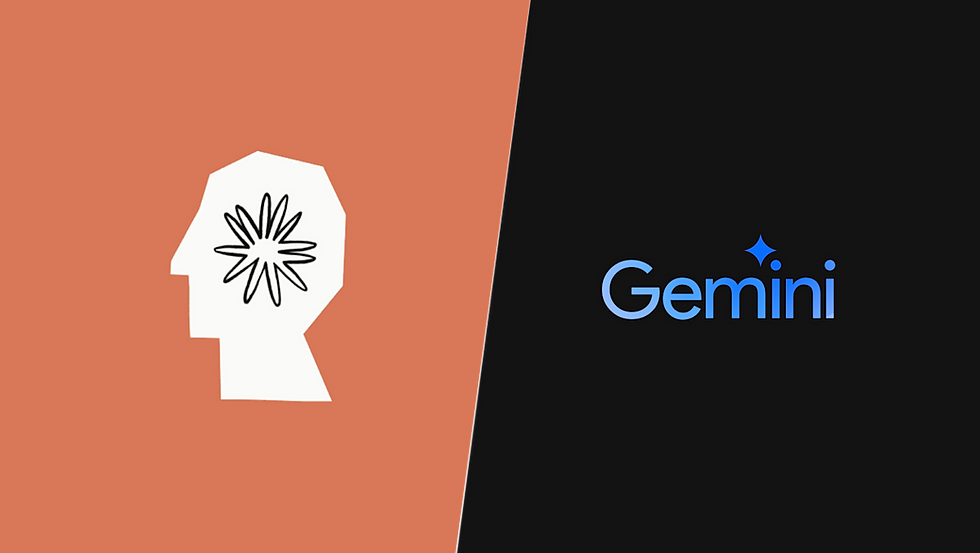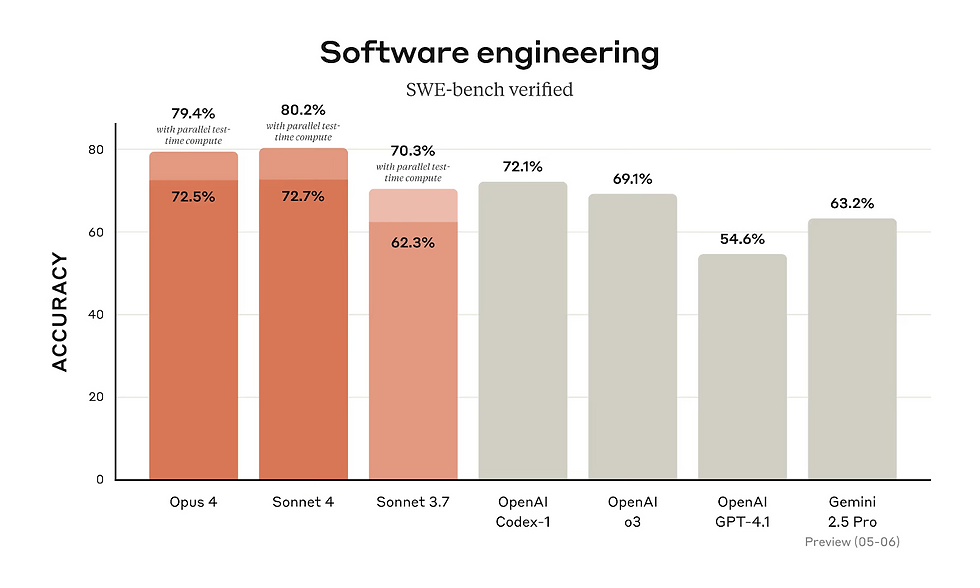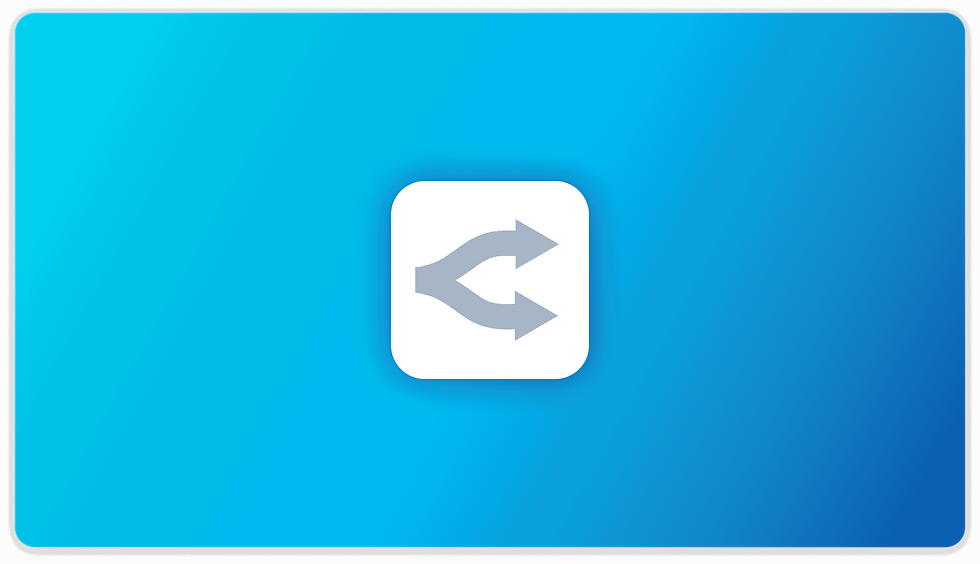Claude 4 vs Gemini 2.5: Which AI Giant Will Dominate Your Workflow in 2025?
- Aisha Washington

- Aug 9
- 11 min read
In the rapidly evolving landscape of artificial intelligence, staying ahead means choosing the right tools to enhance productivity, creativity, and decision-making. Two of the most talked-about AI models poised to redefine workflows in 2025 are Claude 4 and Gemini 2.5. Both promise groundbreaking capabilities, yet they cater to slightly different user needs and industry demands.
This comprehensive comparison will dissect the strengths, weaknesses, and practical applications of Claude 4 and Gemini 2.5. By the end of this article, you’ll have a clear understanding of which AI giant is best suited to transform your workflow in the year ahead.
Introduction to Claude 4 and Gemini 2.5
Artificial intelligence is more than just a buzzword; it’s a transformative force reshaping industries from healthcare to finance to creative arts. Among the latest contenders in AI innovation, Claude 4, developed by Anthropic, and Gemini 2.5, Google DeepMind's latest iteration, stand out as powerful tools designed to optimize workflow efficiency.
Claude 4 builds on its predecessors by emphasizing safety, contextual understanding, and conversational nuance — traits that make it particularly appealing for enterprises requiring sensitive handling of data and complex problem-solving.
On the other hand, Gemini 2.5 pushes the envelope with multimodal capabilities, incorporating language, vision, and reasoning in a single model to deliver highly versatile AI services — ideal for users seeking rich data interaction across formats.
Understanding how these two AI titans compare will help businesses and individual users alike make informed decisions about integrating AI into their daily operations.
Core Technology and Architecture

Claude 4: Safety-Centric Transformer Model
Claude 4 is built upon Anthropic’s proprietary Constitutional AI approach, which incorporates explicit ethical guidelines into training to minimize harmful outputs and biases. This method goes beyond traditional supervised learning by embedding a “constitution” — a set of principles and ethical constraints — into the model’s decision-making process. This enables Claude 4 to self-evaluate its responses in real time and adjust outputs to avoid problematic or biased content.
The model uses large-scale transformer architectures with tens of billions of parameters, designed to excel in deep contextual understanding. This architecture optimizes for reduced hallucinations, meaning Claude 4 is less likely to generate fabricated or misleading information, a critical feature in high-stakes environments like legal or medical domains.
Claude 4’s adaptive learning capabilities allow it to continually refine its responses based on user feedback and evolving datasets. This creates a dynamic AI assistant that improves over time, aligning closely with enterprise needs for accuracy and reliability.
In practice, Claude 4’s architecture supports complex multi-turn conversations, enabling it to maintain context over lengthy interactions — a vital trait for customer support, consulting, or negotiation workflows.
Gemini 2.5: Multimodal and Multitask Mastery
Gemini 2.5 epitomizes Google DeepMind’s ambition to create an AI system capable of understanding and reasoning across multiple data modalities simultaneously. Its architecture integrates vision-language transformers that can process and fuse information from text, images, and structured data streams in real time.
The model incorporates reinforcement learning from human feedback (RLHF), allowing it to learn nuanced human preferences and reasoning patterns. Advanced reasoning layers enable Gemini 2.5 to perform complex problem-solving tasks such as logical deduction, mathematical computations, and hypothesis testing.
One of Gemini 2.5’s standout features is its ability to contextualize visual data alongside textual inputs. For example, it can analyze a scientific chart, interpret the data trends, and generate a coherent written summary — all within a single interaction. This multimodal fusion opens up new workflows in research, education, and creative production.
Gemini 2.5’s architecture is also designed to handle multitasking efficiently, allowing users to switch between diverse tasks without losing context or performance. This flexibility is particularly useful in dynamic work environments where data formats and goals frequently change.
Feature | ||
|---|---|---|
Model Type | Transformer-based Large Language Model | Multimodal Transformer |
Parameters | Tens of billions | Tens of billions |
Training Focus | Ethical alignment & safety | Multimodal integration & reasoning |
Core Strength | Language understanding & generation | Cross-format data comprehension |
Primary Use Cases | Legal, enterprise workflows | Research, creative production |
Performance Benchmarks and Use Cases

Natural Language Understanding & Generation
Claude 4’s performance shines brightest in scenarios demanding precise and reliable language comprehension. Its reduced hallucination rate significantly lowers the risk of generating false or misleading information, which is crucial when drafting legal contracts, regulatory documents, or compliance reports. For example, law firms have integrated Claude 4 to automate contract review, identifying ambiguous clauses and suggesting clarifications without compromising confidentiality.
In customer service, Claude 4 powers chatbots that handle sensitive personal data, such as banking inquiries or healthcare support, by maintaining strict contextual awareness and ethical guardrails. Its ability to manage multi-turn conversations ensures that customer interactions remain coherent and personalized over extended sessions.
In software development, Claude 4 assists programmers by offering context-aware code completions, debugging suggestions, and documentation generation. This is particularly valuable in complex projects where understanding legacy code and dependencies is essential.
Benchmark results reinforce Claude 4’s strengths: on the SuperGLUE natural language understanding suite, it consistently ranks near the top, demonstrating superior reasoning and comprehension capabilities compared to peers.
Multimodal Processing & Reasoning
Gemini 2.5’s multimodal prowess unlocks new possibilities for workflows involving diverse data types. In healthcare, for example, it can simultaneously analyze medical imaging (like X-rays or MRIs) alongside patient records and lab results, offering diagnostic suggestions or flagging anomalies that might be missed by single-modality models.
Researchers use Gemini 2.5 to generate comprehensive reports by synthesizing data visualizations, textual research notes, and experimental images. This streamlines the traditionally laborious process of collating findings from multiple sources.
Creative professionals leverage Gemini 2.5 to brainstorm and prototype multimedia content, combining text prompts with image inputs and audio snippets to generate cohesive narratives, storyboards, or marketing materials. This multimodal interaction fosters a more intuitive and fluid creative process.
On Massive Multitask Language Understanding (MMLU) benchmarks, Gemini 2.5 demonstrates remarkable versatility, maintaining high accuracy across a wide array of tasks including reasoning, summarization, and cross-modal synthesis.
Real-World Applications
Claude 4 is extensively adopted in financial services for compliance monitoring, where it automates the extraction and verification of regulatory clauses, reducing manual review times by up to 40%. Its ethical safeguards ensure that sensitive information is handled appropriately, minimizing legal risks.
Gemini 2.5 is embedded in scientific research platforms, enabling scientists to query experimental datasets using natural language combined with image inputs, accelerating hypothesis testing and data interpretation. It also supports educational tools that provide interactive multimodal tutoring, enhancing student engagement.
Additional sectors benefitting from these models include:
Healthcare: Claude 4 assists in generating patient discharge summaries, while Gemini 2.5 aids radiologists by interpreting scans alongside clinical notes.
Marketing: Gemini 2.5’s ability to generate integrated multimedia campaigns speeds up content creation, whereas Claude 4 ensures messaging compliance and tone consistency.
Legal Tech: Claude 4 automates contract analysis and risk assessment, reducing the workload on legal teams.
These performance distinctions translate into practical workflow enhancements depending on your industry requirements.
Explore further performance metrics at Papers with Code, a hub for AI benchmark tracking.
Integration and Workflow Compatibility

Claude 4: Enterprise-Friendly APIs
Anthropic offers Claude 4 through well-documented, enterprise-focused API endpoints designed for straightforward integration with existing business software ecosystems. These APIs support RESTful calls and WebSocket connections, enabling real-time conversational agents and batch processing workflows.
Privacy and compliance are prioritized, with built-in features allowing enterprises to enforce data residency requirements and audit logs for regulatory reporting. Claude 4’s APIs support fine-grained prompt engineering, enabling developers to customize AI behavior to suit domain-specific jargon, tone, and response styles.
Multi-turn conversation support allows Claude 4 to maintain context over prolonged interactions, making it ideal for complex workflows such as case management or customer lifecycle management.
Claude 4 has been successfully integrated into popular platforms like Salesforce, where it automates lead qualification and customer support ticket triaging. Its Slack integration enhances team collaboration by summarizing threads and generating action items, saving teams valuable time.
Enterprises also benefit from Anthropic’s dedicated support and consulting services, facilitating smoother deployment and ongoing optimization.
Gemini 2.5: Google Ecosystem Synergy
Gemini 2.5’s integration is deeply woven into the Google Cloud ecosystem, enabling seamless interoperability with Google Workspace, BigQuery, Google Kubernetes Engine, and TensorFlow. This tight coupling simplifies the deployment of AI-powered applications at scale.
Google Cloud APIs provide native support for multimodal workflows, allowing developers to easily combine text, image, and structured data inputs within unified pipelines. AutoML tools enable further customization and fine-tuning of Gemini 2.5 to meet specific business needs without requiring extensive machine learning expertise.
Scalability is a hallmark of Gemini 2.5 deployments, leveraging Google’s global network of data centers to ensure low latency and high availability even under heavy load.
Google Cloud’s robust security and compliance certifications (including ISO 27001, HIPAA, and FedRAMP) offer additional peace of mind for regulated industries.
Companies using Gemini 2.5 benefit from Google’s extensive partner ecosystem, which includes third-party plugins and connectors for popular enterprise tools, accelerating integration timelines.
Integration Aspect | Claude 4 | Gemini 2.5 |
|---|---|---|
API Availability | Yes, enterprise-focused APIs | Yes, Google Cloud API family |
Third-party Plugins | Growing marketplace | Extensive via Google Cloud partners |
Customization Level | High with prompt tuning | High via Google AutoML & pipelines |
Cloud Compatibility | Cloud-agnostic | Optimized for Google Cloud Platform |
User Experience and Accessibility

Claude 4: Designed for Precision Users
Claude 4’s user experience is tailored to professionals who prioritize accuracy, transparency, and control. Its interfaces feature interactive dashboards that allow users to monitor AI outputs in real time and adjust conversational parameters dynamically. This level of control is essential in domains like legal analysis or financial auditing, where precision is paramount.
Transparency tools provide explanations for AI-generated content, helping users understand the reasoning behind specific suggestions or conclusions. This fosters trust and facilitates human-in-the-loop workflows where AI acts as an assistant rather than an autonomous agent.
Accessibility is a core consideration, with multilingual support enabling global teams to collaborate effectively. Claude 4 also offers keyboard navigation, screen reader compatibility, and adjustable contrast modes to accommodate diverse user needs.
These features make Claude 4 particularly attractive to industries that require audit trails, regulatory compliance, and meticulous documentation.
Gemini 2.5: Versatile Interface with Creative Flare
Gemini 2.5’s user experience emphasizes flexibility and creativity. Its interfaces commonly support drag-and-drop image uploads, voice input, and mixed-media queries, empowering users to interact with AI in natural and intuitive ways.
The platform’s collaboration tools enable teams to co-create documents, presentations, and multimedia projects, with AI assisting in real-time content generation and refinement. For example, marketing teams can brainstorm campaign ideas by combining textual prompts with visual mockups, receiving instant AI feedback.
Voice recognition and synthesis capabilities make Gemini 2.5 suitable for accessibility applications and hands-free workflows, such as field research or education.
Creative professionals and researchers appreciate Gemini’s ability to handle diverse content types within a single environment, reducing the friction of switching between specialized tools.
Both models provide comprehensive Software Development Kits (SDKs) that allow developers to build customized frontends optimized for specific user groups or industries.
Both models offer extensive SDKs allowing developers to build tailored frontends matching user needs.
Security, Privacy, and Ethical Considerations

Claude 4’s Ethical Framework
Anthropic’s commitment to responsible AI is embedded deeply in Claude 4’s design philosophy. The Constitutional AI methodology enforces strict ethical guidelines that limit the generation of harmful or biased content. This approach involves iterative self-critique by the model, where outputs are evaluated against a predefined constitution to ensure alignment with ethical standards.
Claude 4 employs advanced data anonymization and minimization techniques, ensuring that sensitive or personally identifiable information (PII) is protected during processing. Enterprises can configure data retention policies and access controls to comply with industry-specific regulations such as HIPAA for healthcare or GDPR for data privacy.
Continuous monitoring systems detect anomalous usage patterns or potential misuse, allowing organizations to respond proactively to security threats or ethical breaches.
This rigorous ethical framework makes Claude 4 particularly suitable for sectors where trustworthiness and compliance are non-negotiable, including finance, healthcare, and government.
Gemini 2.5’s Privacy Features
Google implements robust security protocols around Gemini 2.5, leveraging decades of experience managing large-scale cloud infrastructure. Data transmitted to and from Gemini 2.5 is protected by end-to-end encryption, both in transit and at rest, safeguarding against interception or unauthorized access.
User consent frameworks govern data usage, ensuring that organizations maintain transparency and control over how AI-generated insights are derived and stored. Google offers comprehensive tools for auditing AI interactions, enabling enterprises to track model behavior and data flows for compliance and governance purposes.
Regular fairness and bias audits are published by Google, demonstrating commitment to maintaining equitable AI outcomes. These audits are aligned with international standards such as the OECD AI Principles, which emphasize transparency, accountability, and human-centered values.
Security Aspect | Claude 4 | Gemini 2.5 |
|---|---|---|
Data Privacy | Strong anonymization & compliance focus | Enterprise-grade encryption |
Bias Mitigation | Constitutional constraints & audits | Fairness audits & transparency tools |
Regulatory Compliance | HIPAA, GDPR-ready frameworks | GDPR & CCPA aligned |
Choosing between these models may depend on your organization’s risk tolerance and regulatory environment.
Pricing Models and Scalability

Claude 4: Subscription & Usage-Based Pricing
Anthropic offers flexible pricing tiers designed to accommodate a broad spectrum of users, from startups experimenting with AI to large enterprises deploying at scale. Their pay-as-you-go plans allow organizations to control costs by paying only for the compute and API calls they consume.
Volume discounts incentivize large-scale deployments, making Claude 4 a cost-effective choice for companies with extensive AI workloads. Enterprise packages often include dedicated account management, priority support, and customized service-level agreements (SLAs).
Anthropic also provides limited free trial access, enabling potential users to evaluate the model’s capabilities before committing financially.
The pricing structure aligns well with organizations seeking predictable expenses combined with the flexibility to scale AI usage dynamically as business needs evolve.
Gemini 2.5: Google Cloud Consumption Model
Gemini 2.5 is offered through Google Cloud’s consumption-based billing model, which charges customers based on compute time, storage, and API call volume. This granular billing enables precise cost tracking and optimization, particularly for variable workloads.
Integration with Google Cloud’s billing ecosystem simplifies financial management by consolidating AI expenses with other cloud services. Organizations can leverage Google’s cost management tools to set budgets, alerts, and forecasts.
Enterprise agreements are available for high-volume users, offering negotiated pricing, dedicated support, and enhanced SLAs.
Thanks to the elasticity of Google Cloud’s infrastructure, Gemini 2.5 scales seamlessly to accommodate spikes in demand, supporting global deployments with minimal latency.
Pricing Factor | Claude 4 | Gemini 2.5 |
|---|---|---|
Payment Structure | Subscription + usage fees | Pay-as-you-go via cloud consumption |
Enterprise Discounts | Available | Available |
Free Trial | Limited trial access | Free tier via Google Cloud Platform |
For detailed pricing information, visit Anthropic Pricing and Google Cloud Pricing
Conclusion: Choosing Your AI Partner for 2025
Both Claude 4 and Gemini 2.5 represent the cutting edge of AI technology poised to dominate workflows in the coming years. Your choice depends largely on your specific use cases:
Opt for Claude 4 if your priority is ethical alignment, precision in language tasks, and enterprise-grade safety. Its design is ideal for sectors where trustworthiness is non-negotiable, such as legal, finance, and healthcare. Claude 4’s strength in maintaining nuanced, context-rich conversations and minimizing hallucinations makes it a reliable partner for high-stakes decision-making.
Choose Gemini 2.5 if you need multimodal capabilities, versatility across data types, and seamless integration within the Google ecosystem. It suits creative professionals, researchers, and organizations that require the ability to process and reason across text, images, and structured data simultaneously. Gemini 2.5’s scalability and rich interface options make it ideal for dynamic, data-intensive environments.
Both platforms are powerful allies in boosting productivity through intelligent automation — aligning your priorities with their unique strengths will unlock maximum value.
For future-readiness, monitor ongoing updates from both Anthropic and Google DeepMind as they continue refining these models toward even greater capability and accessibility.
FAQ: Claude 4 vs Gemini 2.5
Q1: Which AI model is better for legal document analysis?
Claude 4 is generally preferred due to its strong focus on language precision, ethical safeguards, and reduced hallucinations—crucial for legal contexts. Its constitutional AI framework ensures outputs adhere to strict compliance and accuracy standards.
Q2: Can Gemini 2.5 handle image inputs alongside text?
Yes! Gemini 2.5 is designed as a multimodal model capable of processing images, text, and other data formats simultaneously. This enables richer data interpretation and more versatile AI-assisted workflows.
Q3: How do these models ensure user data privacy?
Both employ robust encryption and comply with major regulations like GDPR; Claude uses constitutional AI principles to enforce ethical use, while Google implements end-to-end encryption and audit tools to maintain transparency and control.
Q4: Are these models accessible to small businesses?
Yes, both offer scalable pricing plans accommodating startups to enterprises. Claude 4’s subscription tiers and Gemini 2.5’s pay-as-you-go model provide flexibility for organizations of all sizes.
Q5: Can I customize model responses?
Claude 4 supports prompt engineering for customization; Gemini integrates with Google AutoML tools allowing fine-tuning and pipeline optimization tailored to specific business needs.


